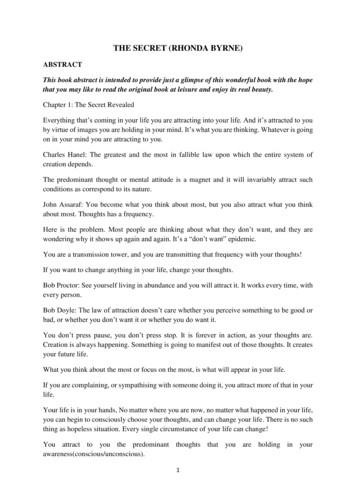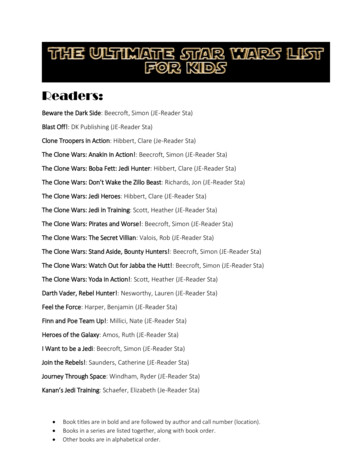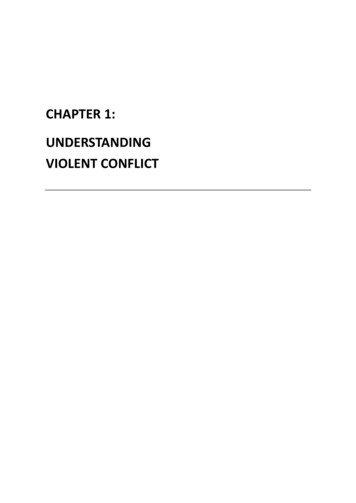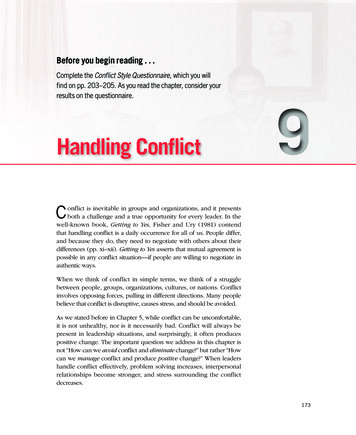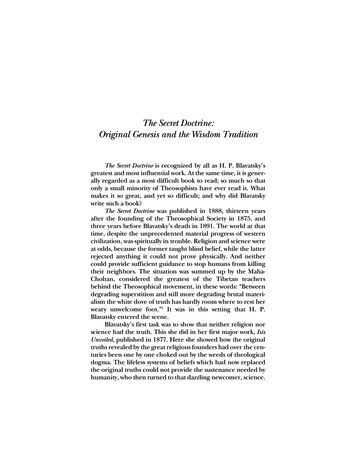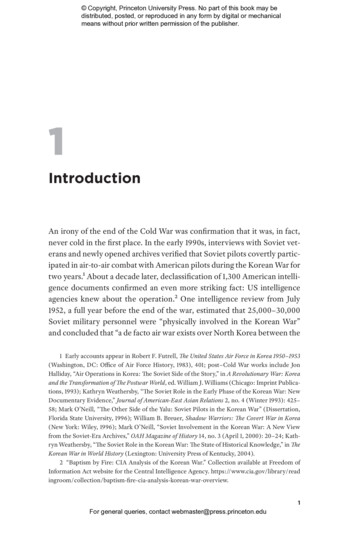
Transcription
Copyright, Princeton University Press. No part of this book may bedistributed, posted, or reproduced in any form by digital or mechanicalmeans without prior written permission of the publisher.1IntroductionAn irony of the end of the Cold War was confirmation that it was, in fact,never cold in the first place. In the early 1990s, interviews with Soviet veterans and newly opened archives verified that Soviet pilots covertly participated in air- to- air combat with American pilots during the Korean War fortwo years.1 About a decade later, declassification of 1,300 American intelligence documents confirmed an even more striking fact: US intelligenceagencies knew about the operation.2 One intelligence review from July1952, a full year before the end of the war, estimated that 25,000– 30,000Soviet military personnel were “physically involved in the Korean War”and concluded that “a de facto air war exists over North Korea between the1 Early accounts appear in Robert F. Futrell, The United States Air Force in Korea 1950– 1953(Washington, DC: Office of Air Force History, 1983), 401; post– Cold War works include JonHalliday, “Air Operations in Korea: The Soviet Side of the Story,” in A Revolutionary War: Koreaand the Transformation of The Postwar World, ed. William J. Williams (Chicago: Imprint Publications, 1993); Kathryn Weathersby, “The Soviet Role in the Early Phase of the Korean War: NewDocumentary Evidence,” Journal of American- East Asian Relations 2, no. 4 (Winter 1993): 425– 58; Mark O’Neill, “The Other Side of the Yalu: Soviet Pilots in the Korean War” (Dissertation,Florida State University, 1996); William B. Breuer, Shadow Warriors: The Covert War in Korea(New York: Wiley, 1996); Mark O’Neill, “Soviet Involvement in the Korean War: A New Viewfrom the Soviet- Era Archives,” OAH Magazine of History 14, no. 3 (April 1, 2000): 20– 24; Kathryn Weathersby, “The Soviet Role in the Korean War: The State of Historical Knowledge,” in TheKorean War in World History (Lexington: University Press of Kentucky, 2004).2 “Baptism by Fire: CIA Analysis of the Korean War.” Collection available at Freedom ofInformation Act website for the Central Intelligence Agency. r general queries, contact webmaster@press.princeton.edu
Copyright, Princeton University Press. No part of this book may bedistributed, posted, or reproduced in any form by digital or mechanicalmeans without prior written permission of the publisher.2C h a p ter 1UN and the USSR.”3 In short, the Cold War started hot.4 Yet neither Moscow nor Washington gave any public indication that direct combat was taking place.This episode is a dramatic example of the two related phenomena thisbook seeks to understand. The Soviet entry in the Korean War is a case ofcovert military intervention, in which an external power secretly providesmilitary assistance during a war. The American decision to stay silent afterdetecting Russian pilots is a case of collusion, in which one governmentdetects but does not publicize or confirm the secret intervention of anothergovernment. The episode raises two related but distinct questions. First,why use a covert form of intervention, especially if it will be detected by anadversary? Second, why would an adversary play along?The conspiracy of silence that emerged in the Korean War is but oneexample of a broader phenomenon. In political campaigns, rival candidatesmay uncover evidence of secret legal or ethical violations by their opponents. While going public with such information is tempting, exposure couldforce the rival candidate to respond in kind and lead to a rash of attack adsand inflammatory accusations. Such mudslinging could depress turnoutand open the door for other candidates, creating good reason for mutualrestraint regarding secrets.5 Childhood family dynamics also feature reciprocal secret keeping. Two siblings often know about one another’s secrets,be it hidden Halloween candy, forged homework, or a clandestine romanticrelationship. Exposing the other’s secret to teachers or parents, while tempting, might prompt a reaction that neither sibling wants. If this scenariolooms, then a sustainable conspiracy of silence could emerge. Finally, firmsmay find evidence that their competitor uses offshore bank accounts toevade taxes. The detecting firm may be tempted to expose and undermineits competitor’s advantage. Yet doing so risks provoking regulators to moreclosely scrutinize the industry as a whole. One reasonable response wouldbe mutual restraint in keeping secret such tax evasion.3 National Intelligence Estimate, “Communist Capabilities and Probable Courses of Actionin Korea,” NIE- 55/1, 30 July 1952, Foreign Relations of the United States, 1952– 1954, Korea, volume 15, part 1.4 Other well- known episodes in which casualties were inflicted despite the “Cold War”moniker include the shootdown of U- 2 surveillance flights in 1960 and during the Cuban MissileCrisis. On shootdown incidents, see the account of twenty- nine such incidents in Alexander L.George, Case Studies of Actual and Alleged Overflights, 1930– 1953— — Supplement, RAND Research Memorandum, August 15, 1955, RM- 1349 (S).5 E.g., Wioletta Dziuda and William Howell, “Political Scandal,” unpublished manuscript,University of Chicago, 2018.For general queries, contact webmaster@press.princeton.edu
Copyright, Princeton University Press. No part of this book may bedistributed, posted, or reproduced in any form by digital or mechanicalmeans without prior written permission of the publisher.I ntro d u cti o n3In each example, a mutually unacceptable outcome influences both theinitial act of secrecy and the response by one who finds the secret. The central insight is that mutual silence may result if individuals, firms, or governments can act secretly, observe one another doing so, and share fear of amutually damaging outcome. Cooperative secrecy of this sort is not so surprising for siblings that live together or firms that might price fix or colludein other ways. However, such behavior is quite surprising in world politics,especially during war. That collusive secrecy would emerge among rivalsunder anarchy is especially unexpected.This book analyzes the politics of secrecy in war and puzzling featureslike tacit collusion among adversaries. Secrecy has long been a hallmark ofinternational politics where “incentives to misrepresent” can be powerfulfor governments that must fend for themselves.6 Seeing states act covertlyis not surprising per se. After all, secrecy can be essential for protectingmilitary forces in the field and for operational surprise.7 Hence the adagesthat “loose lips sink ships” and “tittle tattle lost the battle.” Yet secrecy in theKorean War example appears to be serving different ends. Covert activitywas observable to the rival. Rather than being in the dark, Moscow’s adversary had a unique window into its covert behavior. Moreover, secrecy inthis case seems to have been mutually beneficial. Both the American and theSoviet leaders appeared to derive value from keeping the public and othergovernments in the dark.This book links such decisions to limited war dynamics and the desirefor escalation control. Large- scale conflict escalation is a mutually damaging outcome that is influenced by exposure decisions. I develop a theoryin which initial covertness and reactive secrecy are driven by the need tocontrol escalation and avoid large- scale conflict. When escalation risks aresignificant, adversaries will tend to share an interest in prioritizing control.External military involvement in a local war raises the prospect of expansion in scope and scale. Intervening covertly, however, allows both the intervener and its rivals to better control what scenario unfolds following theintervention. Keeping an intervention covert— that is, acting on the “backstage” rather than the “frontstage”— has two limited- war benefits: easingconstraints from a domestic audience and improving communication about6 James D. Fearon, “Rationalist Explanations for War,” International Organization 49, no. 3(Summer 1995): 379– 414.7 Robert Axelrod, “The Rational Timing of Surprise,” World Politics 31, no. 2 ( January 1979):228– 46; Branislav L. Slantchev, “Feigning Weakness,” International Organization 64, no. 3 (2010):357– 88.For general queries, contact webmaster@press.princeton.edu
Copyright, Princeton University Press. No part of this book may bedistributed, posted, or reproduced in any form by digital or mechanicalmeans without prior written permission of the publisher.4C h a p ter 1interest in limited war. Covertness minimizes domestic hawkish pressuresand expresses a mix of resolve and restraint that supports limited war. Inthe Korean War, covertness regarding the Soviet role allowed each side tooperate with fewer constraints, to save face as it limited war, and to haveconfidence that its adversary valued limiting the conflict. This happenedbecause of, rather than in spite of, detection by the other side. A centralfinding of the book is that this is not one- of- a- kind. Rather, covertness andcollusion are an important part of wars ranging from the Spanish Civil Warin the 1930s to the American occupation of Iraq in the 2000s.Beyond developing a novel logic for secrecy in war, this book also offersnew insights into the very nature of modern war. In the wake of two devastating world wars in the first half of the twentieth century, how did greatpowers avoid a third? Nuclear weapons, democracy, and bipolarity aretypical answers.8 This book provides a different take on this question. AsO’Brien notes, wars still erupted after 1945 despite these larger changes butwere “guided by the principle that the conflict should be geographicallylimited to the immediate overt belligerents.”9 I show that leaders learnedover time to use covertness and collusion to avoid domestic constraints andmiscommunication that might otherwise lead to large- scale escalation. Thisbook underscores that overtness is an important qualification and identifieshow it came to be. Conflicts like the Korean and Vietnam Wars featureddirect casualties among the major powers on the backstage. Moreover, understanding these historical links between limited war and secrecy offerspractical lessons for policymakers responding to tragic and potentially explosive civil wars in places like Syria, Ukraine, and Yemen.Secret Wars also holds broader theoretical implications for scholars ofInternational Relations (IR) beyond the study of secrecy itself. For example,the secret side of war I analyze yields new insights about domestic politicsand statecraft. Subsequent chapters feature infamous personalist dictatorslike Adolf Hitler cautiously navigating the dangers of conflict escalation via8 E.g., Kenneth N. Waltz, Theory of International Politics, 1st ed. (New York: McGraw- HillHumanities/Social Sciences/Languages, 1979); John Mueller, “The Essential Irrelevance of Nuclear Weapons: Stability in the Postwar World,” International Security 13, no. 2 (1988): 55– 79;John Mueller, Retreat from Doomsday: The Obsolescence of Major War (New York: Basic Books,1989); Steven Pinker, The Better Angels of Our Nature: The Decline of Violence In History And ItsCauses (New York: Penguin Books Limited, 2011).9 William V. O’Brien, The Conduct of Just and Limited War (New York: Praeger, 1981), 230;emphasis added.For general queries, contact webmaster@press.princeton.edu
Copyright, Princeton University Press. No part of this book may bedistributed, posted, or reproduced in any form by digital or mechanicalmeans without prior written permission of the publisher.I ntr o d u cti o n5covertness and collusion. These otherwise unobservable policy decisionsshowcase caution on the part of leaders and regime types better known forreckless aggression. Regarding democracies, the book shows that democratic leaders often detect but stay silent about covert activity by other governments. This is an under- recognized way in which presidents and primeministers can deceive and manipulate domestic elites and public opinionwhich raises questions about accountability and transparency in democracy.The book also provides new insight into how states under anarchy communicate. Covert intervention takes place in a distinct communicative venueduring war. This backstage is visible to other major powers and can allowgovernments to send and receive messages, including regarding escalationand limited war. This metaphor of a theater provides a heuristic use for thestudy of war more generally. Rather than conceptualizing war as simply abargaining process dividing up finite spoils, the book suggests the promiseof conceptualizing war as a kind of performance. Later chapters show howmajor powers move between visible and hard- to- observe spaces to managethe image and meaning of their clashes. Doing so protects the performanceof limited war and produces collaborative patterns like collusion that areotherwise hard to explain.The TopicThis book addresses two questions. First, why do states intervene covertlyrather than overtly? Second, when covert interventions take place, why dodetecting states collude rather than expose? Secrecy, defined as intentionalconcealment of information from one or more audiences, is simply oneway of making decisions and behaving in the world. Secrecy can be used regarding state deliberations, government decisions, communications amongheads of state, or externally oriented policy activity. Secrecy, moreover,requires effort. Especially for complex organizations like states, effectivelyconcealing decisions and actions requires information control in the formof physical infrastructure, rules, penalties, and organizational habits. A termclosely related to secrecy, which I use when discussing military intervention specifically, is “covert.” Covertness is defined as government- managedactivity conducted with the intention of concealing the sponsor’s role andavoiding acknowledgment of it. It has a narrower scope than the term “secrecy” because it is specific to a state’s externally oriented behaviorrather than discrete decisions, refers to the sponsor’s identity rather thanFor general queries, contact webmaster@press.princeton.edu
Copyright, Princeton University Press. No part of this book may bedistributed, posted, or reproduced in any form by digital or mechanicalmeans without prior written permission of the publisher.6C h a p ter 1operational details or outcomes, and explicitly incorporates the concept ofnon- acknowledgment.10I specifically assess secrecy regarding external military interventions.An intervention is combat- related aid given by an outside state to a combatant in a local civil or interstate conflict that includes some role for personnel. An overt intervention involves weaponry and personnel sent to awar zone without restrictions on visibility and with behavioral and verbalexpressions of official acknowledgment. A covert intervention, in contrast,features an external power providing such aid in a way that conceals its roleand does not feature official acknowledgment. Covert intervention is aspecific form of covert operation, distinct from covert surveillance, regimechange, or other operation that does not aim to alter battlefield dynamics.11States can covertly intervene by providing weaponry that lacks militarylabeling or appears to originate from a different source; they may send military personnel in unmarked civilian uniforms, as “volunteers,” or as “military advisors.” Much existing research has focused on why states interveneand on intervention’s effect on war duration and other outcomes. I focuson the how of intervention, specifically, covert compared to overt forms.Such a focus is both theoretically important and timely. Just in the last tenyears, the list of countries that have reportedly featured covert external involvement by major powers includes Ukraine, Syria, Libya, Somalia, Pakistan, and Yemen. 1210 See chapter 2 for additional discussion of these terms. Note that clandestine is a relatedterm which tends to connote concealment of both sponsor and the fact that there was an operation. See Alexandra H. Perina, “Black Holes and Open Secrets: The Impact of Covert Action onInternational Law,” Columbia Journal of Transnational Law 53 (2014): 512.11 Alexander B. Downes and Mary Lauren Lilley, “Overt Peace, Covert War?: Covert Intervention and the Democratic Peace,” Security Studies 19, no. 2 (2010): 271– 72.12 Roy Allison, “Russian ‘Deniable’ Intervention in Ukraine: How and Why Russia Brokethe Rules,” International Affairs 90, no. 6 (2014): 1255– 97. On Syria, see Greg Miller, “CIA Ramping up Covert Training Program for Moderate Syrian Rebels,” Washington Post, October 2, 11e3-8ade-a1f23cda135estory.html; Mark Mazzetti, Adam Goldman, and Michael S. Schmidt, “Behind the Sudden Deathof a 1 Billion Secret C.I.A. War in Syria,” New York Times, August 2, 2017, sec. Middle leeast/cia-syria-rebel-arm-train-trump.html. For Libya, Mark Hosenball, “Exclusive: Obama Authorizes Secret Help for Libya Rebels,”Reuters, March 30, 2011, idUSTRE72T6H220110330; “France Gave Libyan Rebels Weapons,” BBC News, June 29, 2011, sec. Africa, http://www.bbc.com/news/world-africa-13955751.For Somalia, Mark Mazzetti, “U.S. Is Said to Expand Secret Military Acts in Mideast Region,”New York Times, May 24, 2010, .html?hp.For general queries, contact webmaster@press.princeton.edu
Copyright, Princeton University Press. No part of this book may bedistributed, posted, or reproduced in any form by digital or mechanicalmeans without prior written permission of the publisher.I ntr o d u cti o n7Covert interventions raise a second- order question regarding secrecy:If detected, will others keep the secret too? This question is especially germane for other major powers that are most likely to detect a given covertintervention. Providing military aid beyond one’s borders for months oryears is a significant undertaking, no matter the scope. Doing so withoutpartial exposure is difficult enough. In addition, major powers tend to invest significant resources in intelligence bureaucracies. To be clear, detectors often remain in the dark about many details. However, the sponsor ofa covert intervention is often discernible. Any detector has two basic options: collude or expose. Exposure involves publicly revealing evidencethat a covert intervention is underway and/or publicly validating allegations by others. Collusion, in contrast, involves staying silent. There is aninformational component of collusion; the detector must keep evidence ofa covert intervention private rather than share it widely. There is also anacknowledgment component: a colluder must publicly deny or stay silentabout allegations of a covert intervention made by others such as the media.Two PuzzlesThe study of secrecy, deception, and related aspects of informational misrepresentation are at last getting their due in IR. In the past ten years, newresearch has been published on secrecy in diplomacy and deal- making,prewar crisis bargaining, military operations, elite decision- making, alliances, and international institutions.13 This has been joined by related workFor Pakistan, “Secret Memos Reveal Explicit Nature of U.S., Pakistan Agreement on Drones,”Washington Post, October 23, 2013. For Yemen, Robert Booth and Ian Black, “WikiLeaks Cables:Yemen Offered US ‘open Door’ to Attack Al- Qaida on Its Soil,” December 3, 2010, aks-yemen-us-attack-al-qaida; Karen McVeigh, “ ‘Trump’sSecret Yemen War’: UK Role in US Counter- Terrorism Causes Unease,” Guardian, September25, 2017, -terrorism-causes-unease.13 On diplomacy, David Stasavage, “Open- Door or Closed- Door? Transparency in Domestic and International Bargaining,” International Organization 58, no. 04 (2004): 667– 703; KerenYarhi- Milo, “Tying Hands Behind Closed Doors: The Logic and Practice of Secret Reassurance,”Security Studies 22, no. 3 (2013): 405– 35; Jonathan N. Brown, “Immovable Positions: Public Acknowledgment and Bargaining in Military Basing Negotiations,” Security Studies 23, no. 2 (April3, 2014): 258– 92; Jonathan N. Brown, “The Sound of Silence: Power, Secrecy, and InternationalAudiences in US Military Basing Negotiations,” Conflict Management and Peace Science 31, no. 4(September 1, 2014): 406– 31; Corneliu Bjola and Stuart Murray, Secret Diplomacy: Concepts,Contexts and Cases (New York: Routledge, 2016); Shawn L. Ramirez, “Mediation in the Shadowof an Audience: How Third Parties Use Secrecy and Agenda- Setting to Broker Settlements,”Journal of Theoretical Politics, September 25, 2017, 0951629817729227. On crisis bargaining,For general queries, contact webmaster@press.princeton.edu
Copyright, Princeton University Press. No part of this book may bedistributed, posted, or reproduced in any form by digital or mechanicalmeans without prior written permission of the publisher.8C h a p ter 1on covert operations, deception and lying, intelligence, and declassification.14 Two predominant logics for the appeal of secrecy provide initialintuition about the book’s two specific research questions. The most prevalent view is that information misrepresentation helps insecure states protect their security under anarchy. Here secrecy is directed at adversaries.Especially during war, effective concealment of new weapons, troop locations, or an operational naval vulnerability can be essential to avoidinglosses and harnessing the power of surprise. A second strand of researchemphasizes secrecy’s link to domestic politics. For research on securityand conflict, the dominant emphasis is on democratic leaders avoidingdovish, antiwar constraints. Leaders might circumvent public constraintsto initiate war against a threatening foe or change the regime of a fellowdemocracy.Shuhei Kurizaki, “Efficient Secrecy: Public Versus Private Threats in Crisis Diplomacy,” American Political Science Review 101, no. 03 (2007): 543– 58; Jonathan N. Brown and Anthony S. Marcum, “Avoiding Audience Costs: Domestic Political Accountability and Concessions in CrisisDiplomacy,” Security Studies 20 (April 2011): 141– 70. On operational benefits of surprise, AdamMeirowitz and Anne E. Sartori, “Strategic Uncertainty as a Cause of War,” Quarterly Journal ofPolitical Science 3, no. 4 (December 2008): 327– 52; Slantchev, “Feigning Weakness”; DavidLindsey, “Military Strategy, Private Information, and War,” International Studies Quarterly 59,no. 4 (December 1, 2015): 629– 40; Austin Carson, “Facing Off and Saving Face: Covert Intervention and Escalation Management in the Korean War,” International Organization 70, no. 01(2016): 103– 31; Austin Carson and Keren Yarhi- Milo, “Covert Communication: The Intelligibility and Credibility of Signaling in Secret,” Security Studies 26, no. 1 ( January 2, 2017): 124– 56.On elite decision- making, Elizabeth N. Saunders, “War and the Inner Circle: Democratic Elitesand the Politics of Using Force,” Security Studies 24, no. 3 ( July 3, 2015): 466– 501. On alliances,Jeffrey Ritter, “Silent Partners” and Other Essays on Alliance Politics (Cambridge, MA: HarvardUniversity Press, 2004); Muhammet Bas and Robert Schub, “Mutual Optimism as a Cause ofConflict: Secret Alliances and Conflict Onset,” International Studies Quarterly 60, no. 3 (September 1, 2016): 552– 64. On international organizations, Emilie M. Hafner- Burton, Zachary C.Steinert- Threlkeld, and David G. Victor, “Predictability versus Flexibility: Secrecy in International Investment Arbitration,” World Politics 68, no. 3 ( June 23, 2016): 413– 53.14 Downes and Lilley, “Overt Peace, Covert War?”; Lindsey A. O’Rourke, Covert RegimeChange: America’s Secret Cold War (Ithaca, NY: Cornell University Press, 2018); Michael Poznansky, “Stasis or Decay? Reconciling Covert War and the Democratic Peace,” International StudiesQuarterly, March 1, 2015; Michael F. Joseph and Michael Poznansky, “Media Technology, Covert Action, and the Politics of Exposure,” Journal of Peace Research, November 16, 2017,0022343317731508. On deception and lying, John M. Schuessler, “The Deception Dividend:FDR’s Undeclared War,” International Security 34, no. 4 (2010): 133– 65; John J. Mearsheimer,Why Leaders Lie: The Truth about Lying in International Politics (New York: Oxford UniversityPress, 2011); Dan Reiter, “Democracy, Deception, and Entry into War,” Security Studies 21, no. 4(2012): 594– 623; John M. Schuessler, Deceit on the Road to War: Presidents, Politics, and American Democracy (Ithaca, NY: Cornell University Press, 2015); Erik Gartzke and Jon R. Lindsay,“Weaving Tangled Webs: Offense, Defense, and Deception in Cyberspace,” Security Studies 24,For general queries, contact webmaster@press.princeton.edu
Copyright, Princeton University Press. No part of this book may bedistributed, posted, or reproduced in any form by digital or mechanicalmeans without prior written permission of the publisher.I ntro d u cti o n9To be clear, each of these perspectives sheds light on covert aspects ofwar. Yet some shortcomings suggest there is more to the story, presentingtwo empirical puzzles. First, existing research provides little reason to expect adversaries to collude. The operational security logic sees informationmanipulation as part of the broader pursuit of security at the expense ofrivals, whereas the domestic dove logic focuses on domestic concerns thatare not directly related to an adversary’s interests. If anything, these logicswould expect a rival that detects a covert intervention to expose it, eitherto neutralize any operational advantage or to trigger domestic dovish constraints in the intervener. And yet we have historical documentation ofcases in which rival powers did allow detection of covert operations anddid collude in this way. Examples include Chinese and Soviet borderclashes before 1969, aerial clashes from covert American surveillanceflights over Soviet territory, and the covert dimension of Iran- Israel rivalrytoday.15A second puzzle also underscores the need for a fresh approach.Whether or not major powers collude, covert intervention can be widelyexposed by non- state actors like media organizations. This can be due toenterprising journalism on the ground or simple bureaucratic leaks. Recent examples include the Russian covert role in eastern Ukraine and theno. 2 (April 3, 2015): 316– 48. On intelligence, Joshua Rovner, Fixing the Facts: National Securityand the Politics of Intelligence (Ithaca, NY: Cornell University Press, 2011); Robert Jervis, WhyIntelligence Fails: Lessons from the Iranian Revolution and the Iraq War (Ithaca, NY: Cornell University Press, 2011); James Igoe Walsh, The International Politics of Intelligence Sharing (NewYork: Columbia University Press, 2013); Keren Yarhi- Milo, “In the Eye of the Beholder: HowLeaders and Intelligence Communities Assess the Intentions of Adversaries,” International Security 38, no. 1 (2013): 7– 51; Keren Yarhi- Milo, Knowing the Adversary: Leaders, Intelligence, andAssessment of Intentions in International Relations (Princeton, NJ: Princeton University Press,2014); Jonathan N. Brown and Alex Farrington, “Democracy and the Depth of Intelligence Sharing: Why Regime Type Hardly Matters,” Intelligence and National Security 32, no. 1 ( January 2,2017): 68– 84. On declassification, Michael P. Colaresi, Democracy Declassified: The Secrecy Dilemma in National Security (New York: Oxford University Press, 2014).15 Thomas W. Robinson, “The Sino- Soviet Border Dispute: Background, Development, andthe March 1969 Clashes,” American Political Science Review 66, no. 04 (1972): 1175– 1202. On surveillance flights, George notes that “in fourteen cases of Soviet action against a Western plane,neither side disclosed the incident either diplomatically or publicly . . . the Russians prefer tomake no disclosure at all of action they take against an intruding foreign plane. In only three ofthe thirty- one cases did the Soviets themselves initiate disclosure.” Alexander L. George, SovietReaction to Border Flights and Overflights in Peacetime, RAND Research Memorandum, 15 October 1954, RM- 1346 (TS- 1106), p. 2. On Iran- Israel, Karl Vick, “Spy Fail: Why Iran Is Losing ItsCovert War with Israel,” Time, February 13, 2013, -is-losing-its-covert-war-with-israel/.For general queries, contact webmaster@press.princeton.edu
Copyright, Princeton University Press. No part of this book may bedistributed, posted, or reproduced in any form by digital or mechanicalmeans without prior written permission of the publisher.10C h a p ter 1American covert aid program in the Syrian Civil War. Widely exposed covertinterventions become a kind of open secret. Such a scenario would obviatesecrecy’s value as a device to address dovish critiques (domestic dove logic)or deceive an adversary (operational security logic). A puzzle therefore ariseswhen covert interveners maintain a covert posture despite open secrecy.This is possible because covert activity can remain officially unacknowledgedeven if is widely visible. Examples of exposed- but- unacknowledged statebehavior include Israel’s nuclear weapons arsenal, the American drone strikeprogram in Pakistan, and Russia’s “little green men” in Eastern Ukraine.16If the pretense of covertness is valuable even after wi
The book also provides new insight into how states under anarchy commu - nicate. Covert intervention takes place in a distinct communicative venue during war. This backstage is visible to other major powers and can allow governments to


